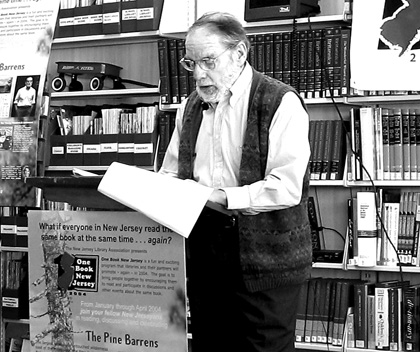
| NEWS |
| |
| FEATURES |
| ENTERTAINMENT |
| COLUMNS |
| CONTACT US |
| HOW TO SUBMIT |
| BACK ISSUES |

caption:
|
Princeton Author John McPhee's Book Chosen as Book of the Year for N.J.
Candace Braun
Princeton author John McPhee's The Pine Barrens was chosen as One Book New Jersey's book for 2004. It will be featured in public libraries throughout the state, and will be the focus of many educational forums in New Jersey schools this year.
"I'm really glad this book was chosen for this purpose," said Mr. McPhee, a Pulitzer-Prize winner and author of 26 books.
The book was launched at a press conference held on Wednesday, January 21, at the Princeton Public Library's temporary location in the Princeton Shopping Center.
Published in 1967, Mr. McPhee's book preserves the tales of truth and myth told to him by those who have lived in the Pine Barrens. The Jersey Devil and a witch that transforms into various animals are just two of the unseemly characters that Mr. McPhee writes about.
Mr. McPhee first started researching his book 40 years ago when he was searching for material to write for The New Yorker. A friend with whom he had attended Princeton High School gave him the idea to research the Pine Barrens, where "there's holes in the ground so deep there that there's no bottom, and the people are dangerous."
After travelling to the area and speaking with the inhabitants, Mr. McPhee was able to create a captivating story on the woods, but not as he had anticipated.
"There were no holes in the ground, and the people were wonderful," said Mr. McPhee.
The Pine Barrens delves into the history of the New Jersey Pinelands, a vast stretch of forests that once covered 1,875 square miles of New Jersey, about a quarter of the state. Known as the Pine Barrens since the 17th century, it is the largest body of open space on the Mid-Atlantic seaboard, covering vast areas of Burlington, Camden, Cape May, Cumberland, Gloucester, and Atlantic Counties.
Now, as developers have moved into the land, there are only approximately 1,000 square miles left.
Soon after Mr. McPhee's book was published, a National Geographic photographer contacted the author to do a piece for the magazine. The two went back together to explore this vast wilderness in a state with the heaviest population density of any in the country.
Mr. McPhee said that he hasn't often been asked to return to a subject or area he has previously written about. In most cases, he said, it is too difficult to go back.
"It's very hard to become involved with a piece and the people involved and have to leave it," he said.
Mr. McPhee said that of all the places he has written about for his numerous books, "I've been back to the Pine Barrens more than anywhere else."
The author's most recent visit to the area was a few years ago, when he went canoeing with a friend.
When asked his favorite spot in the 1.1 million acres of undeveloped land, the author recalled a fire tower on top of Bear Swamp Hill that offered a bird's eye view of the entire surrounding area.
However, sometime since his first visit to the Pine Barrens, a jet fighter plane hit the tower, destroying it. Mr. McPhee said "it would be wonderful" if someone built an observation tower in its place.
Among others who were enthused about the book being chosen as the statewide read, was Carleton Montgomery, executive director of the Pinelands Preservation Alliance.
"John McPhee's The Pine Barrens is one of the very few examples I know of a book that is not only a joy to read, but is also a work of art that made a very real difference in the real world," said Mr. Montgomery.
The book brought public attention to the area, which helped persuade then Governor Brendan Byrne to lead the legislative efforts to preserve the land, said Mr. Montgomery. Today, the Pinelands Protection Act and the Pinelands Comprehensive Management Plan keep the land from suffering further development.
Born in Princeton in 1931, Mr. McPhee was raised and educated here, earning an English degree from Princeton University. He then furthered his studies at Cambridge University. He wrote for the television program, Robert Montgomery Presents in the late 1950s, and was on staff at Time magazine in the 1950s and 1960s, while continually submitting work to The New Yorker, where he aspired to work. His first published piece for the magazine was a 1965 profile on Princeton basketball star Bill Bradley.
The piece later became his first book, A Sense of Where You Are.
Since then the author has averaged almost one book per year, with an award in literature from the American Academy of Arts and Letters in 1977. His book Annals of the Former World received a Pulitzer Prize in 1999.
His most recent book, The Founding Fish, was published in October 2002. The book discusses the history of shad fishing, employing broad research and humor as he shows how the creature played a role in the lives of certain historical figures, from Henry David Thoreau to John Wilkes Booth.
Currently, Mr. McPhee is a staff writer for The New Yorker.
